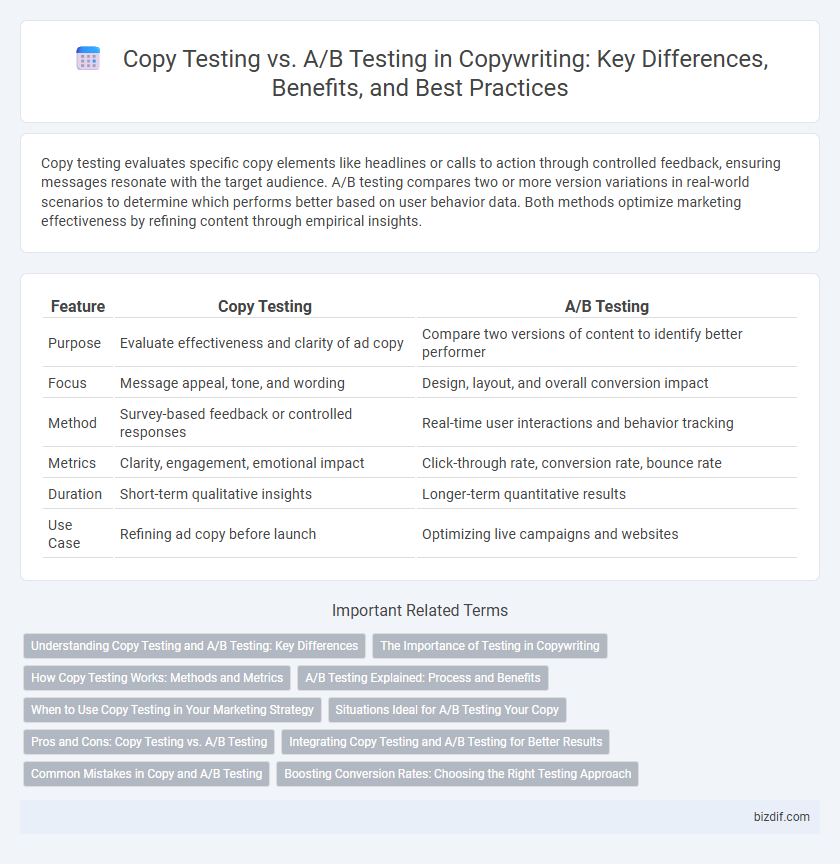Copy testing evaluates specific copy elements like headlines or calls to action through controlled feedback, ensuring messages resonate with the target audience. A/B testing compares two or more version variations in real-world scenarios to determine which performs better based on user behavior data. Both methods optimize marketing effectiveness by refining content through empirical insights.
Table of Comparison
| Feature | Copy Testing | A/B Testing |
|---|---|---|
| Purpose | Evaluate effectiveness and clarity of ad copy | Compare two versions of content to identify better performer |
| Focus | Message appeal, tone, and wording | Design, layout, and overall conversion impact |
| Method | Survey-based feedback or controlled responses | Real-time user interactions and behavior tracking |
| Metrics | Clarity, engagement, emotional impact | Click-through rate, conversion rate, bounce rate |
| Duration | Short-term qualitative insights | Longer-term quantitative results |
| Use Case | Refining ad copy before launch | Optimizing live campaigns and websites |
Understanding Copy Testing and A/B Testing: Key Differences
Copy Testing evaluates the effectiveness of specific ad copy by measuring consumer reactions such as recall, comprehension, and persuasiveness before full campaign rollout. A/B Testing compares two or more variations of digital content, including headlines or calls to action, by analyzing real-time user behavior and conversion rates to determine which version performs better. Understanding these key differences helps marketers choose the appropriate method for optimizing copy based on research goals and platform metrics.
The Importance of Testing in Copywriting
Testing in copywriting is crucial for identifying which messages resonate best with target audiences, improving engagement and conversion rates. Copy testing evaluates the effectiveness of specific copy elements such as headlines, calls to action, and emotional appeal, while A/B testing compares different variations to determine which performs better in real-time scenarios. Thorough testing ensures data-driven decisions, enhancing the overall impact and return on investment of marketing campaigns.
How Copy Testing Works: Methods and Metrics
Copy testing evaluates the effectiveness of advertising copy by analyzing audience reactions through qualitative and quantitative methods such as focus groups, surveys, eye tracking, and heat maps. Key metrics include comprehension, engagement, recall, and persuasion, which help determine how well the copy resonates and drives desired behaviors. This data-driven approach identifies strengths and weaknesses in messaging before full-scale campaign deployment.
A/B Testing Explained: Process and Benefits
A/B testing involves comparing two versions of a webpage or ad copy to determine which performs better by analyzing key metrics such as click-through rates, conversions, and engagement levels. This process includes creating variations, randomly segmenting the audience, running tests simultaneously, and using statistical analysis to identify the dominant version. Benefits of A/B testing include data-driven decision making, improved marketing effectiveness, and optimized user experience through continuous refinement.
When to Use Copy Testing in Your Marketing Strategy
Copy testing should be used when you need in-depth qualitative insights into how your target audience perceives and emotionally responds to your message, helping refine tone, clarity, and persuasion before full campaign rollout. It is most effective during the early stages of content development to identify potential misunderstandings or unintended negative reactions that quantitative data alone might miss. Integrating copy testing into your marketing strategy ensures that your messaging resonates authentically and drives higher engagement and conversion rates.
Situations Ideal for A/B Testing Your Copy
A/B testing your copy is ideal when you need to compare specific headlines, calls-to-action, or product descriptions to determine which version drives higher conversion rates or engagement metrics. This method excels in scenarios where quantifiable performance data, such as click-through rates or sales, directly measures the effectiveness of small, controlled variations in your copy. Marketers benefit most from A/B testing during email campaigns, landing pages, and PPC ads where precise modifications can significantly impact user behavior.
Pros and Cons: Copy Testing vs. A/B Testing
Copy Testing provides in-depth insights into emotional response and message clarity by evaluating various creative elements before launch, ensuring alignment with target audience preferences but can be time-consuming and costly. A/B Testing offers real-time performance data by comparing two variants in the live environment, enabling quick optimization based on actual user behavior, though it may lack qualitative feedback and take longer to gather statistically significant results. Balancing Copy Testing's qualitative depth with A/B Testing's quantitative agility helps optimize campaign effectiveness and ROI.
Integrating Copy Testing and A/B Testing for Better Results
Integrating copy testing and A/B testing enhances campaign effectiveness by combining qualitative insights with quantitative data. Copy testing evaluates message clarity, emotional resonance, and brand alignment through audience feedback, while A/B testing measures real-time performance of variations across targeted metrics. Leveraging both methodologies allows marketers to refine messaging based on consumer psychology and actual engagement results, optimizing conversion rates and overall ROI.
Common Mistakes in Copy and A/B Testing
Common mistakes in copy testing include relying on subjective feedback instead of measurable engagement metrics, leading to biased conclusions about copy effectiveness. In A/B testing, errors like testing too many variables simultaneously or having inadequate sample sizes often result in inconclusive or misleading data. Both methods require clear hypotheses and focused testing to accurately identify which copy resonates best with the target audience.
Boosting Conversion Rates: Choosing the Right Testing Approach
Copy testing evaluates the effectiveness of different copy elements by measuring emotional impact and message clarity, driving deeper audience connection essential for boosting conversion rates. In contrast, A/B testing compares two variations of a webpage or ad to identify which version drives higher click-through and conversion rates based on real user behavior. Selecting the right approach depends on whether the goal is to refine persuasive messaging (copy testing) or optimize specific design and content elements through data-driven experimentation (A/B testing).
Copy Testing vs A/B Testing Infographic

 bizdif.com
bizdif.com